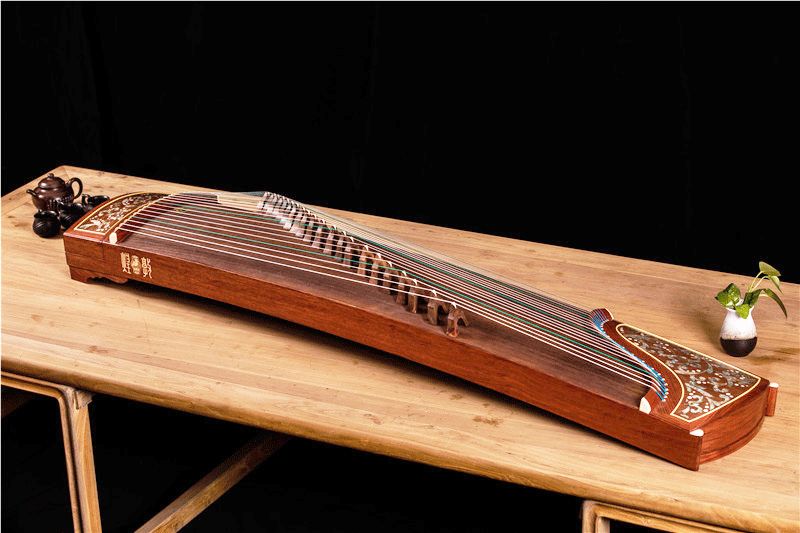The Origin and Development History of Guzheng
3131 views · Organized by 山霁 on 2022-02-07
As early as the Warring States Period from the 5th century BC to the 3rd century BC, the guzheng was widely circulated in the Qin state (now Shaanxi). The origin of the guzheng is still inconclusive. Due to historical changes and regional influences, local styles and playing techniques have been different, and thus various different guzheng schools have been formed today, making the development of guzheng more and more prosperous.

Before the Han and Jin Dynasties, the zheng had twelve strings (see "There are twelve strings" in Wei Ruan Li's "Waizheng Fu").
During the Sui and Tang Dynasties, the zheng was increased from twelve strings to thirteen strings (see Tang Cen Shen's "Qin Zheng Song, Sending Nephew Xiao Zheng Back to Beijing" "If you don't hear the Qin Zheng sound, it is the most bitter, and the five-color strings are wrapped around thirteen columns").
After the Ming and Qing dynasties, it gradually increased to fifteen strings. The "Da Qing Hui Dian" published in the Guangxu period of the Qing Dynasty recorded: "The fifteen strings of Qin Zheng are like a serenity...".
From the end of the Qing Dynasty to the beginning of the Republic of China, a new 16-string zheng appeared. This 16-string first is the traditional zheng that has been popular in China for nearly a hundred years.
After 1949, the zheng, an ancient folk musical instrument, has successfully developed an S-shaped twenty-one-string nylon-steel-wound zheng on the basis of the reform of its shape and string quality through the scrutiny and research of performers and relevant experts. Due to the enlarged resonance body and the increase of the number of strings, this kind of zheng obviously enriches the sound effect and the thickness of the pronunciation. The zheng that has been passed down through the ages is even more euphemistic and beautiful, full of charm. The S-type twenty-one-string nylon-steel-wound zither is a popular zither in China and around the world.
In the 21st century, a group of young guzheng players have emerged, including Wang Zhongshan, Zhai Zhirong, Qiu Ji, Yuan Sha, Jiang Zhoujian, Liu Le, Bao Dong, Song Xinxin and other teachers. Over the years, these performers have visited Germany, Austria, the United Kingdom, France, Italy, the Netherlands, Russia, Belgium, Switzerland, Sweden, Hungary, Poland, Japan, Singapore, Taiwan, Hong Kong and other regions and countries. Make the guzheng musical instrument to the world.
Involving musical instruments
Guzheng (pinyin: Gǔ Zhēng), also known as Hanzheng and Qinzheng, is an ancient national musical instrument of the Han nationality and is popular all over China. It is often used for solo, duet, instrumental ensemble and accompaniment of song and dance, opera and folk art. Because of its wide range, beautiful timbre, rich playing skills and strong expressiveness, it is known as the "King of Music", also known as "Oriental Piano", and is one of the unique and important national musical instruments in China.
Guess you like
Organized by 关谷奇迹 on 2025-04-11
In the world of traditional Chinese music, guzheng pieces stand out for their melodious and graceful tones as well as their profound cultural heritage. Among the many captivating guzheng masterpieces, "Jianchang Moon" shines with its unique artistic charm, becoming a brilliant pearl in the hearts of classical music lovers.
read >>
Organized by vespa on 2025-03-18
Among the numerous guzheng pieces that have been passed down to the present day, "Xunfeng Qu" stands out with its melodious tune, profound emotions, and delicate depiction of natural beauty, making it a rare classic in the hearts of many guzheng enthusiasts.
read >>
Organized by 长恭 on 2025-02-28
"Yuanban Sanliu", as a classic guzheng piece deeply imbued with the charm of Jiangnan silk and bamboo music, not only carries rich historical and cultural connotations but also showcases the development and transformation of guzheng art in different eras.
read >>
Organized by 湛鹰 on 2025-02-21
In the vast starry sky of traditional Chinese music, there is a particularly dazzling star, which is the famous guzheng piece "Dry Thunder". This piece not only conquers the hearts of countless listeners with its unique artistic charm, but also has become one of the important works for guzheng players to showcase their skills.
read >>
Organized by 拙 on 2025-01-05
As a traditional musical instrument with wood as its main material, Guzheng is very sensitive to changes in the environment, especially in the cold and dry winter, and improper maintenance may lead to damage such as string pine and wood cracking.
read >>
 渝公网安备 50010702504639号
渝公网安备 50010702504639号